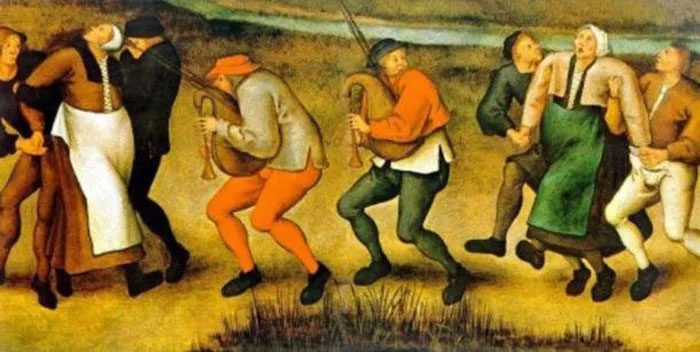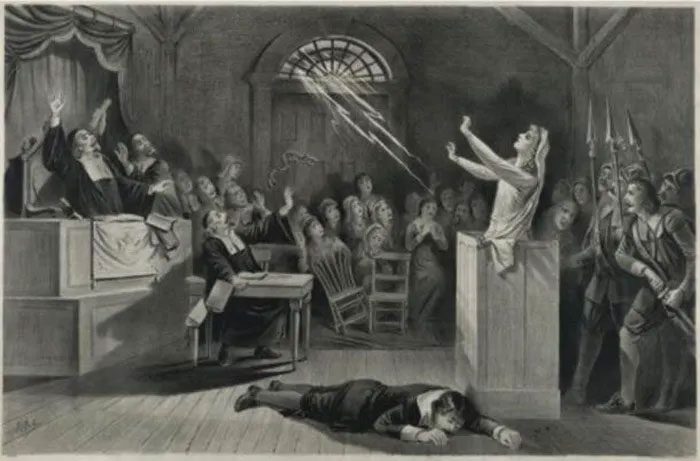By the medieval period, this belief was replaced by the notion that the causes were witches, demonic possession, or madness. Although the emergence of mass hysteria continued to baffle the medical community, it is now often thought to be related to cases of extreme mental or emotional stress.
Below are some famous – and bizarre – cases of mass hysteria throughout history.
Medieval Mania (13th – 17th Century)

Pieter Brueghel the Younger (1564–1638) depicts the dancing mania that occurred during a pilgrimage to a church in Molenbeek, Belgium. (Wikimedia Commons)
The Dancing Plague, also known as St. Vitus’ Dance, St. John’s Dance, or Dance Epidemic, spread across the European continent from the 13th to the 17th century.
One of the most well-known outbreaks occurred in Aachen, Germany, on June 24, 1374. During this time, those afflicted would dance frantically in the streets for hours, days, or even months, until they collapsed from exhaustion or died from heart attacks or strokes. The number of participants in any given outbreak could reach into the thousands.
The Dancing Plague is known to have occurred multiple times throughout medieval Europe, with outbreaks reported in Italy, Luxembourg, France, Germany, the Netherlands, and Switzerland. Initially, dancing mania was thought to be a curse sent by a saint, often believed to be St. John the Baptist or St. Vitus.
As a result, those suffering from this condition would travel to the shrines dedicated to the aforementioned saints to pray for relief from their affliction, a ‘remedy’ that seemed to help many return to full health.
The Nuns’ Biting (15th Century)
In the 15th century, another mass hysteria occurred in Germany when a nun in a convent began biting her fellow sisters. Before long, this behavior spread throughout the convent, and as news spread further, the phenomenon also erupted, leading to biting outbreaks across Germany, the Netherlands, and Italy.
According to a 15th-century physician: “A nun in a convent in Germany bit all of her companions. In a short time, all the nuns of this convent began to bite each other. The news of this obsession among the nuns quickly spread, and now it had transferred through the convents to nuns across much of Germany, primarily in Saxony, and then it visited the convents in the Netherlands and eventually, the nuns had the biting mania even as far as Rome.”
The church believed that the nuns were possessed and attempted to perform exorcisms, but this did not stop the behavior. Eventually, they resorted to threats of punishment or being dunked in water for any nun caught biting another. After a few instances of nuns being punished, the behavior quickly subsided.
The Salem Witch Trials (1692–1693)

Representation of the Salem Witch Trials. Lithograph from 1892 by Joseph E. Baker. (Wikimedia Commons)
One of the most famous cases of mass hysteria occurred in Salem, Massachusetts, in 1692. Dozens of young girls exhibited uncontrollable screaming and convulsions, which ultimately led to a series of witchcraft accusations. As a result, a series of trials and prosecutions of those accused of witchcraft, known as the Salem Witch Trials, led to the deaths of 25 citizens of Salem and neighboring towns.
The Salem Witch Trials, an event that has become a significant moment in American history, have been used in political discourse and popular literature to highlight the dangers of isolationism, religious extremism, false accusations, and breakdowns in the judicial process.
The French Nuns (19th Century)
Institutional settings such as schools, prisons, and tightly-knit communities often serve as breeding grounds for outbreaks of mass hysteria, and Christian communities in Europe were no exception. In JFC Hecker’s 1844 book “Medieval Epidemiology,” there is a story about a nun in a convent in France who began meowing like a cat. Soon after, other nuns began to exhibit similar behavior, until the entire convent was disrupted by nuns meowing. This caused alarm among the surrounding Christian community, and eventually, soldiers were called in to try to control the situation. The nuns were whipped and beaten by the soldiers until they promised to stop making the deafening noises. During this era, belief in possession was common, and in France, cats were often thought to be loyal to the devil.
The Tanganyika Laughter Epidemic (1962)
The Tanganyika Laughter Epidemic began on January 30, 1962, at a girls’ boarding school in Kashasha, Tanzania. Laughter started among three girls but quickly spread throughout the school, lasting hours, days, and then weeks, leading to the school’s closure on March 18, 1962. But the situation did not end there. After the school was closed, the mass hysteria spread to other schools and eventually to neighboring villages. Thousands of children were affected by the epidemic, and 14 schools were forced to shut down. The frenzy eventually subsided about eighteen months after it began.
Cases of mass hysteria seem to contradict an increasingly educated public, who no longer believe in wandering wombs, demonic possession, or witchcraft as explanations. Yet, mass hysterias continue to occur; a recent case unfolded in 2012 when 1,900 children at 15 schools in Sri Lanka were treated for a range of symptoms including skin rashes, dizziness, and coughs with no clear physical cause.
While instances of hysteria may be easily dismissed as absurd and bizarre behavior, research has shown that there are several complex factors that may contribute to the formation and spread of collective hysteria, including social anxiety, cultural pressure, rumors, fear, unusual excitement, religious beliefs, reinforcement of actions by authority figures, and extreme stress.
The social, political, and religious contexts have changed over the centuries, but human psychology largely remains the same, and for this reason, we may see many more instances of mass hysteria in the future.





















































